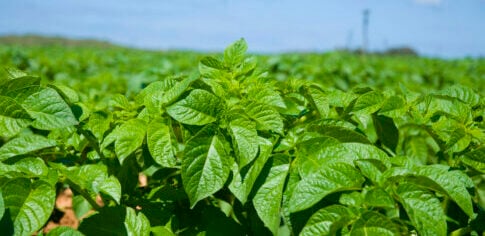Growing Potato crop nutrition advice
Everything you need to know about fertilising potatoes, best practice, suitable products, field trials and more.
Crop nutrition advice for growing potato
-
Potatoes perform best in soil with a pH between 5.5 and 6.7.
-
Potatoes thrive well and give the best yield in sandy loam to slit loam organically rich and well-drained soil.
-
In soils with a high pH (above 7.5) phosphorus mainly, but also other micronutrients deficiencies may appear.
-
In high pH conditions potatoes are susceptible to scab bacterial infection caused by Streptomyces scabies.
-
The optimum conditions for root development and tuber initiation are well drained, aerated soils, with temperatures between 15 and 20 °C.
-
Shorter days will help tuber initiation whereas longer days will delay it.

Potato plants with healthy leaves

Potatoes harvested in optimum condition
The Significance of Potatoes in the UK
Potatoes hold a paramount position in the agricultural landscape of the United Kingdom. They stand as one of the essential and widely cultivated crops, contributing significantly to the nation’s economy and culinary heritage. In the United Kingdom, a diverse range of potato varieties is cultivated to meet various culinary and agricultural needs. Commonly grown varieties include the Maris Piper, the King Edward and the Desiree variety. Their versatility, nutritional value, and adaptability make them a staple in British cuisine and a crucial part of the agricultural sector.
Extent of Potato Cultivation in the UK
The UK boasts a substantial cultivation of potatoes, with approximately ?? hectares of land dedicated to potato farming annually. This widespread cultivation reflects the integral role of potatoes in meeting both domestic and international market demands.
Many major food companies within the UK heavily rely on the steady supply and quality of potatoes for their products. From chips to crisps, mashed potatoes to various processed foods, these companies depend on the consistent yield and quality of potatoes to maintain their production lines and satisfy consumer demand.
What are the nutrient Requirements of a potato crop?
Potatoes have specific nutrient needs critical for their growth and yield. Key nutrients include nitrogen, phosphorus, potassium, and several micronutrients such as magnesium and calcium. Balancing these nutrients is vital throughout different growth stages to ensure healthy plant development, tuber formation, and disease resistance.
ICL’s innovative range of agricultural solutions, including Polysulphate and Controlled Release Fertilisers can optimise potato yields. Polysulphate, a natural multi-nutrient fertiliser containing sulphur, potassium, magnesium, and calcium, provides essential nutrients crucial for robust potato growth and tuber development. Its balanced composition supports healthy foliage, enhances tuber quality, and improves overall yield.
ICL’s Controlled Release Fertilisers offer a gradual and sustained nutrient release, ensuring a consistent supply of vital elements throughout the potato plant’s growth stages. This controlled nutrient delivery not only maximises nitrogen use efficiency but also minimises nutrient leaching, reducing environmental impact.
By utilising ICL’s Polysulphate and Controlled Release Fertilisers, potato farmers can achieve improved crop health, enhanced yields, and sustainable agricultural practices, contributing to a more productive and environmentally conscious farming approach.
Estimated nutrient uptake (kg/t) by:
| N | P2O5 | K2O | MgO | SO3 | CaO | |
|---|---|---|---|---|---|---|
| Kg/ha | Kg/ha | Kg/ha | Kg/ha | Kg/ha | Kg/ha | |
| Tubers | 3 | 1.5 | 6.5 | 0.4 | 0.7 | 0.5 |
| Above ground biomass | 1.9 | 0.6 | 5.3 | 0.2 | 0.4 | 0.25 |
Source: IPNI
What are the roles of nutrients in potatoes?
Key parameter N P2O5 K2O MgO CaO SO3
Yield ++ + ++ + +/- +/-
Tuber size ++ ++ +
Tuber weight ++ + ++
Skin set - + +
Bruising and handling - + ++ ++
Tuber color (internal blackening) +/- +
Dry matter content - +/- - +/-
Starch content - + +/-
+ = improving
– = decreasing
+/- = different results, depending on the rate of nutrient applied
Source: IPI bulletin – Fertilising for high yield | POTATO
What are the most Common Nutrient Deficiencies in potatoes?
| Nutrient | Description | |
|---|---|---|
| Nitrogen Deficiency | Leaves are pale green (general chlorosis) Old leaves remain yellow, while younger leaves turn darker Plants will produce less stems and tubers |
|
| Phosphorous Deficiency | Plant growth is stunted Darker color than normal Lower leaf surface gray green Leaflets roll upwards if deficiency is severe. It occurs on calcareous and heavy soils, where P can be fixed |
|
| Potassium Deficiency | Potassium deficiency symptoms normally Scorched appearance with black pigmentation and necrotic edges (dead tissues) Symptoms appear on the young, full-sized leaves Common in light soils due to easier leaching. |
|
| Calcium Deficiency | Moderate calcium deficiency may not appear but in severe situations leaf’s margin can be affected Brown blotches may appear around the stolon end of the tubers Tubers may show severe skin cracking Deficiencies are severe in soils with pH below 5 |
|
| Magnesium Deficiency | Chlorosis of leaf margins of older leaves. Yellowing Symptoms appear first on the older leaves, due to its mobility General chlorosis with veins remaining green Scorched appearance caused by interveinal necrosis Can occur on sandy soils and when high K level were applied |
|
| Sulphur Deficiency | Symptoms are similar to nitrogen deficiency, but Deficiency Symptoms occur first in younger leaves (as yellowing similar N deficiency) General chlorosis The yellowing is uniform and general It may occur on loamy sand soils |
How can I spot Nutrient Deficiencies in Potatoes?
If your yield is showing signs of stunted growth, with pale yellow leaves it is likely to have a deficiency in Nitrogen.
If your yield is suffering from weak steams or poor tuber development, this could indicate a deficiency in Potassium which could also make your yield susceptible to diseases.
If your yield is showing slower signs in growth with darkened, purple tinted leaves, this is likely to be a result of deficiency in Phosphorus.




